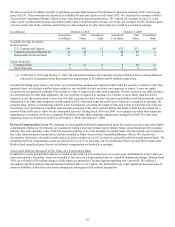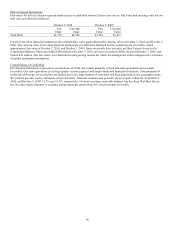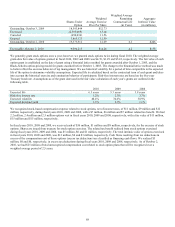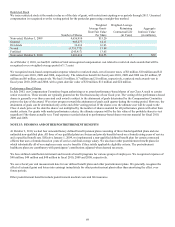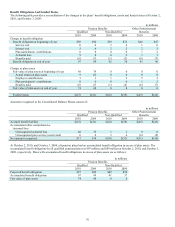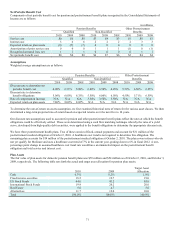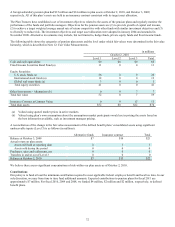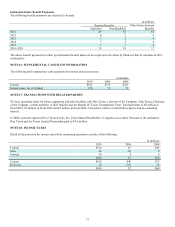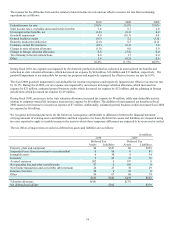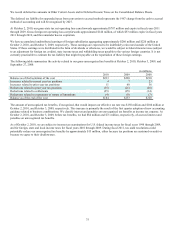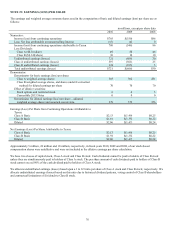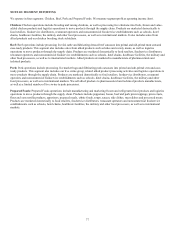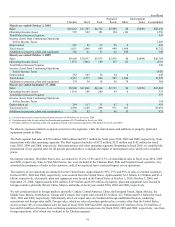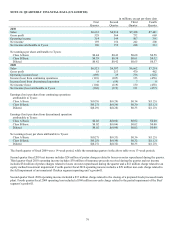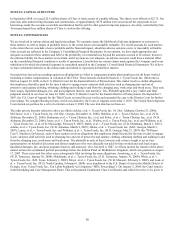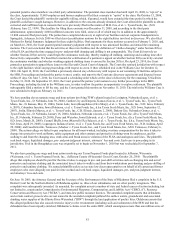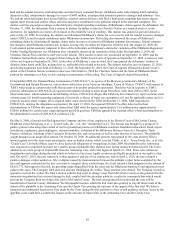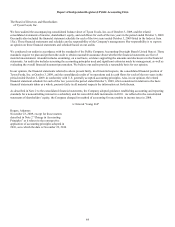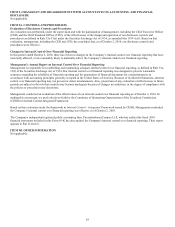Tyson Foods 2010 Annual Report Download - page 75
Download and view the complete annual report
Please find page 75 of the 2010 Tyson Foods annual report below. You can navigate through the pages in the report by either clicking on the pages listed below, or by using the keyword search tool below to find specific information within the annual report.
75
We record deferred tax amounts in Other Current Assets and in Deferred Income Taxes on the Consolidated Balance Sheets.
The deferred tax liability for suspended taxes from conversion to accrual method represents the 1987 change from the cash to accrual
method of accounting and will be recognized by 2027.
At October 2, 2010, our gross state tax net operating loss carryforwards approximated $787 million and expire in fiscal years 2011
through 2029. Gross foreign net operating loss carryforwards approximated $144 million, of which $53 million expire in fiscal years
2011 through 2019, and the remainder has no expiration.
We have accumulated undistributed earnings of foreign subsidiaries aggregating approximately $260 million and $220 million at
October 2, 2010, and October 3, 2009, respectively. These earnings are expected to be indefinitely reinvested outside of the United
States. If those earnings were distributed in the form of dividends or otherwise, we would be subject to federal income taxes (subject
to an adjustment for foreign tax credits), state income taxes and withholding taxes payable to the various foreign countries. It is not
currently practicable to estimate the tax liability that might be payable on the repatriation of these foreign earnings.
The following table summarizes the activity related to our gross unrecognized tax benefits at October 2, 2010, October 3, 2009, and
September 27, 2008:
in millions
2010 2009 2008
Balance as of the beginning of the year $233 $220 $210
Increases related to current year tax positions 4 7 23
Increases related to prior year tax positions 11 60 36
Reductions related to prior year tax positions (35) (21) (28)
Reductions related to settlements (25) (25) (14)
Reductions related to expirations of statute of limitations (4) (8) (7)
Balance as of the end of the year $184 $233 $220
The amount of unrecognized tax benefits, if recognized, that would impact our effective tax rate was $150 million and $104 million at
October 2, 2010, and October 3, 2009, respectively. This increase is primarily the result of the first quarter adoption of new accounting
guidance related to business combinations. We classify interest and penalties on unrecognized tax benefits as income tax expense. At
October 2, 2010, and October 3, 2009, before tax benefits, we had $64 million and $71 million, respectively, of accrued interest and
penalties on unrecognized tax benefits.
As of October 2, 2010, we are subject to income tax examinations for U.S. federal income taxes for fiscal years 1998 through 2009,
and for foreign, state and local income taxes for fiscal years 2001 through 2009. During fiscal 2011, tax audit resolutions could
potentially reduce our unrecognized tax benefits by approximately $15 million, either because tax positions are sustained on audit or
because we agree to their disallowance.


